Janitza UMG 103-CBM Handleiding
Janitza
Niet gecategoriseerd
UMG 103-CBM
Bekijk gratis de handleiding van Janitza UMG 103-CBM (4 pagina’s), behorend tot de categorie Niet gecategoriseerd. Deze gids werd als nuttig beoordeeld door 67 mensen en kreeg gemiddeld 4.8 sterren uit 34 reviews. Heb je een vraag over Janitza UMG 103-CBM of wil je andere gebruikers van dit product iets vragen? Stel een vraag
Pagina 1/4

1 2
www.janitza.de
Dok Nr. 2.057.002.0.b
English version:
see rear side
3
10
14
75 6 Spannungsmessung
m
VORSICHT!
Verletzungsgefahr oder
Beschädigung des Geräts
Durch Nichtbeachtung der Anschlussbedingun-
gen für die Spannungsmesseingänge können
Sie sich verletzen oder das Gerät beschädigen.
Beachten Sie deshalb:
• Die Spannungsmesseingänge
- nicht mit Gleichspannnung belegen.
- mit einer geeigneten, gekennzeichne-
ten und in der Nähe platzierten Siche-
rung und Trennvorrichtung (Alternativ:
Leitungsschutzschalter) versehen.
- sind berührungsgefährlich.
• Spannungen, die die erlaubten Netz-
Nennspannungen überschreiten über
Spannungswandler anschließen.
• Messspannungen und -ströme müssen
aus dem gleichen Netz stammen.
HINWEIS!
• Alternativ zur Sicherung und
Trennvorrichtung können Sie einen
Leitungsschutzschalter verwenden.
• Bei einer Messbereichsüberschrei-
tung blinkt die rote LED (vgl. Schritt
„Anschlüsse und Bedienelemente“).
13
Das Gerät bezieht die Versorgungsspannung aus
der Messspannung.
11 12
Das Gerät ist ein Universalmessgerät für Nieder-
spannungsverteilungsanlagen, dass
• Elektrische Größen, wie Spannung, Strom,
Leistung, Arbeit, Oberschwingungen u. a. in
der Gebäudeinstallation, an Verteilern, Leis-
tungsschaltern und Schienenverteilern misst
und berechnet.
• Messergebnisse über eine Schnittstelle ver-
sendet.
Geräte-Kurzbeschreibung
Das Gerät wird in Schaltschränken oder in
Installationskleinverteilern nach DIN 43880 auf
einer 35 mm Tragschiene nach DIN EN 60715
montiert.
• Das Gerät erfüllt die Einsatzbedingungen
nach DIN IEC 60721-3-3 und ist für den
wettergeschützten, ortsfesten Einsatz vor-
gesehen.
• Die Einbaulage ist beliebig.
• Eine Fremdbelüftung ist nicht erforderlich.
Abb. Gerät auf
Tragschiene nach
DIN EN 60715.
Montage
Versorgungsspannung anlegen
4
c
WARNUNG!
Verletzungsgefahr durch
elektrische Spannung!
Schwere Körperverletzungen oder Tod können
erfolgen, durch:
• Berühren von blanken oder abisolierten
Adern, die unter Spannung stehen.
• Berührungsgefährliche Eingänge des Geräts.
Vor Arbeitsbeginn Ihre Anlage spannungsfrei
schalten! Spannungsfreiheit prüfen!
Das Gerät bezieht seine Versorgungsspannung aus
den Messspannungen L1-N, L2-N und L3-N.
Dabei liegt mindestens eine Phase im Nennspan-
nungsbereich.
Das Gerät benötigt für den Betrieb in mindestens
einer Phase (L-N) eine Spannung von mindestens
100 Veff.
Netzsysteme
Geeignete Netzsysteme und Maximale-Nennspannungen (DIN EN 61010-1/A1):
Anschlüsse und Bedienelemente
Leuchtdiode rot
Leuchtdiode grün
Kodierschalter,
Einstellung der
Geräteadresse
RS485
Schnittstelle
Anschluss Strommessung
Anschluss Mess- und
Versorgungsspannunng
Kodierschalter
Mit den Kodierschaltern konfi gurieren Sie die
Geräteadresse wie folgt:
012
46
753
89012
46
753
89
x10
(10-90)
x1
(1-9)
Mit den Kodierschaltern konfi gurieren
Sie Geräteadressen im Bereich von 01
bis 99.
Die Geräteadresse 00 ist für Service-
zwecke reserviert (Weitere Informatio-
nen im Benutzerhandbuch).
Leuchtdioden
Die grüne LED leuchtet. Mess- und Versor-
gungsspannungen liegen im Betriebsspan-
nungsbereich. Das Gerät ist im Betrieb.
Die LED blinkt alle 5 Sek. für 0,5 Sek.
Beide LEDs leuchten. Das Gerät ist
betriebsbereit. Mindestens eine Mess-
oder die Versorgungsspannung unter-
schreitet die Betriebsspannung.
Die grüne LED blinkt.
Die Datenübertragung (RS485) ist aktiv.
Die LEDs blinken gleichzeitig.
Die Datenübertragung (RS485) ist fehlerhaft.
Die rote LED leuchtet. Fehler im Gerät!
Gerät vom Hersteller prüfen lassen!
Die rote LED blinkt. Mindestens ein Strom-
oder Spannungsmesseingang überschreitet
den Messbereich.
Die LEDs blinken abwechselnd.
Firmware-Checksum-Fehler! Der Betrieb ist
gestört! Führen Sie ein Firmware-Update
durch!
Trennvorrichtung
Sicherung (UL/IEC listed)
L3
N
L1
L2 Last
• Das Gerät misst Spannungen L-N bis 277 V und
L-L bis 480 V.
• Die Bemessungs- und Stoßspannungen entspre-
chen der Überspannungskategorie 300 V CATIII.
8
9
Das Gerät kann in
• TN- und TT-Netzen
• Wohn- und Industriebereichen
eingesetzt werden.
Strommessung
Das Gerät
• ist nur für eine Strommessung über Strom-
wandler zugelassen.
• ist für den Anschluss von Stromwandlern
mit Sekundärströmen von ../1 A und ../5 A
ausgelegt.
• hat als Standard das Stromwandlerverhältnis
5/5 A eingestellt.
• Die Stromwandler müssen über eine Basis-
isolierung gemäß IEC 61010-1:2010 für die
Nennspannung des Stromkreises verfügen.
HINWEIS!
• Weitere Informationen zu Strom- und
Stromwandlerdaten fi nden Sie im
Benutzerhandbuch.
• Stromwandlerverhältnisse konfi gurie-
ren Sie über die Software.
c
WARNUNG!
Verletzungsgefahr durch
elektrische Spannung!
Schwere Körperverletzungen oder Tod
können erfolgen, durch:
• Berühren von blanken oder abisolierten
Adern, die unter Spannung stehen.
• Berührungsgefährliche Strommesseingän-
ge am Gerät und an den Stromwandlern.
Vor Arbeitsbeginn Ihre Anlage spannungs-
frei schalten! Spannungsfreiheit prüfen!
Anlage erden! Verwenden Sie dazu die
Erdanschlussstellen mit Erdungssymbol!
Erden Sie auch die Sekundärwicklungen
von Stromwandlern und alle der Berührung
zugänglichen Metallteile der Wandler!
Anschlussvariante „Direkte Spannungs-
messung im Dreiphasen-Vierleitersystem“.
HINWEIS!
Da das Gerät die Versorgungsspannung
aus der Messspannung bezieht und den
Spannungswandler mit einem nichtlinearen
Strom belastet, ist das Gerät für die Mes-
sung in Mittel- und Hochspannungsnetzen
nur bedingt geeignet.
HINWEIS!
Spannungswandlerverhältnisse
konfi gurieren Sie über die Software.
Anschlussvarianten Spannungsmessung
Dreiphasen-Vierleitersystem Einphasen-Dreileitersystem
Spannungsmessung im
Dreiphasen-Vierleitersystem Spannungsmessung im
Einphasen-Dreleitersystem
Anschlussvarianten Strommessung
Dreiphasen-Vierleitersystem Einphasen-Dreileitersystem
Strommessung über
Stromwandler im Dreiphasen-
Vierleitersystem
Strommessung im Einphasen-
Dreileitersystem
Dreiphasen-Vierleitersystem
Strommessung über 2
Stromwandler im Dreiphasen-
Vierleitersystem
Power Analyser
UMG 103-CBM
Installationsanleitung
• Installation
• Geräte-Einstellungen
Benutzerhandbuch:
Janitza electronics GmbH
Vor dem Polstück 6
D-35633 Lahnau
Support Tel. +49 6441 9642-22
Fax +49 6441 9642-30
E-Mail: info@janitza.de
Internet: http://www.janitza.de
Typische Anschlussvariante
UMG 103-CBM
RS485
2 3
A B
1
Data GND
Strommessung
Current measurement
Mess- und Versorgungsspannung
Measuring and supply voltage
Verbraucher
Load
A
B
Anschlussvariante
im Dreiphasen-
Vierleitersystem“.
Das folgende Schaltbild zeigt eine typische Anschlussvariante des Geräts mit:
• Versorgungsspannung und Spannungsmessung.
• Strommessung.
• RS485-Schnittstelle mit Modbus RTU-Protokoll.
Technische Daten
Spannungsmessung
3-Phasen 4-Leitersysteme
mit Nennspannungen
(L-N/L-L)
max. 277 V/480 V
Netze Messung in TT- und TN-Netzen
Bemessungsstoßspannung 4 kV
Absicherung der
Spannungsmessung 1 - 10 A Auslösecharakteristik B,
(mit IEC-/UL-Zulassung)
Überspannungskategorie 300 V CAT III
Aufl ösung 0,01 V
Crest-Faktor 2 (bez. auf 240 Vrms)
Abtastfrequenz 5,4 kHz
Frequenz der
Grundschwingung -
Aufl ösung
45 Hz .. 65 Hz
0,001 Hz
Fourieranalyse 1.-25. Oberschwingung
(alle ungeraden)
Strommessung
Nennstrom 5 A
Bemessungsstrom 6 A
Crest-Faktor 2 (bez. auf 6 Arms)
Aufl ösung 0,1 mA
Messbereich 0,005 ... 6 Arms
Überspannungskategorie 300 V CAT II
Bemessungsstoßspannung 2 kV
Leistungsaufnahme ca. 0,2 VA (Ri=5 mΩ)
Überlast für 1 Sek. 60 A (sinusförmig)
Abtastfrequenz 5,4 kHz
Versorgungsspannung
Das Gerät bezieht die Versorgungsspannung aus der Messspan-
nung!
Versorgung aus 1er Phase 115 - 277 V (+-10%), 50/60 Hz
Versorgung aus 3 Phasen 80 - 277 V (+-10%), 50/60 Hz
Leistungsaufnahme max. 1,5 VA
Verbindung zum PC herstellen
Folgend sind die 3 gängigsten Verbindungen zur
Kommunikation zwischen PC und Gerät beschrieben:
1. RS485
PC/
GridVis®
RS485
RS485
Anschluss des Geräts
über Schnittstellenwandler.
RS232 RS232
Abb. UMG 103-CBM
HINWEIS!
Installieren Sie auf dem verwendeten PC
die zum Lieferumfang gehörende Software
GridVis®!
2. USB RS485
RS485
RS485
Anschluss des Geräts
über Schnittstellenwandler.
USB
PC/
GridVis®
3.
Anschluss des Geräts
über ein UMG 604 als Gateway.
UMG 604 RS485
Ethernet
RS485
PC/
GridVis®
UMG 103-CBM
HINWEIS!
Bei einer Messbereichsüberschreitung
blinkt die rote LED (vgl. Schritt „An-
schlüsse und Bedienelemente“).
Die PC-Verbindung des Geräts über die serielle
Schnittstelle RS485 mit z.B. einem UMG 604 als
Gateway (vgl. Schritt „Verbindung zum PC herstel-
len“) ist eine Methode, um das Gerät/die Geräte
• zu konfi gurieren und
• Daten auszulesen.
z.B. Anschluss
an das UMG 604
als Gateway (Master)
z.B.
Anschluss
weiterer
Slave-Geräte
Dreiphasen-Vierleitersysteme
mit geerdetem Neutralleiter Dreiphasen-Vierleitersysteme
mit nicht geerdetem Neutralleiter
L1
L2
L3
EE
N
E
L1
L2
L3
E
N
R
UL-N / UL-L
277 VLN / 480 VLL
In diesem Netzsystem das Gerät
nur über Spannungswandler
anschließen!
Art. Nr. 33.03.345
L1 L2 L3 N
BA
Allgemeines
Haftungsausschluss
Die Beachtung der Informationsprodukte zu
den Geräten ist Voraussetzung für den sicheren
Betrieb und um angegebene Leistungsmerk-
male und Produkteigenschaften zu erreichen.
Für Personen-, Sach - oder Vermögensschä-
den, die durch Nichtachtung der Informations-
produkte entstehen, übernimmt die Janitza
electronics GmbH keine Haftung.
Sorgen Sie dafür, dass Ihre Informations-
produkte leserlich zugänglich sind.
Weiterführende Dokumentationen fi nden Sie
auf unserer Website www.janitza.de unter
Support > Downloads.
Urheberrechtsvermerk
© 2016 - Janitza electronics GmbH - Lahnau.
Alle Rechte vorbehalten. Jede, auch auszugs-
weise, Vervielfältigung, Bearbeitung, Verbrei-
tung und sonstige Verwertung ist verboten.
Technische Änderungen vorbehalten
• Achten Sie darauf, dass Ihr Gerät mit der
Installationsanleitung übereinstimmt.
• Lesen und verstehen Sie zunächst produkt-
begleitende Dokumente.
• Produktbegleitende Dokumente während
der gesamten Lebensdauer verfügbar
halten und gegebenenfalls an nachfolgende
Benutzer weitergeben.
• Bitte informieren Sie sich über Geräte-
Revisionen und die damit verbundenen
Anpassungen der produktbegleitenden
Dokumentation auf www.janitza.de.
Entsorgung
Bitte beachten Sie nationale Bestimmungen!
Entsorgen Sie gegebenenfalls einzelne Teile, je
nach Beschaffenheit und existierende länder-
spezifi sche Vorschriften, z.B. als:
• Elektroschrott
• Kunststoffe
• Metalle
oder beauftragen Sie einen zertifi zierten
Entsorgungsbetrieb mit der Verschrottung.
Relevante Gesetze,
angewendete Normen und Richtlinien
Die von der Janitza electronics GmbH ange-
wendeten Gesetze, Normen und Richtlinien für
das Gerät entnehmen Sie der Konformitätser-
klärung auf unserer Website (www.janitza.de).
Sicherheit
Sicherheitshinweise
Die Installationsanleitung stellt kein vollständi-
ges Verzeichnis aller für einen Betrieb des Ge-
räts erforderlichen Sicherheitsmaßnahmen dar.
Besondere Betriebsbedingungen können
weitere Maßnahmen erfordern. Die Installations-
anleitung enthält Hinweise, die Sie zu Ihrer
persönlichen Sicherheit und zur Vermeidung von
Sachschäden beachten müssen.
Verwendete Symbole:
cDieses Symbol als Zusatz zu den
Sicherheitshinweisen deutet auf
eine elektrische Gefahr hin.
mDieses Symbol als Zusatz zu den
Sicherheitshinweisen deutet auf
eine potenzielle Gefahr hin.
Dieses Symbol mit dem Wort
HINWEIS! beschreibt:
• Verfahren, die keine Verlet-
zungsgefahren bergen.
• Wichtige Informationen, Ver-
fahren oder Handhabungen.
Sicherheitshinweise sind durch ein Warndreieck
hervorgehoben und je nach Gefährdungsgrad
wie folgt dargestellt:
m
GEFAHR!
Weist auf eine unmittelbar dro-
hende Gefahr hin, die zu schwe-
ren bzw. tödlichen Verletzungen
führt.
m
WARNUNG!
Weist auf eine möglicherweise
gefährliche Situation hin, die zu
schweren Verletzungen oder Tod
führen kann.
m
VORSICHT!
Weist auf eine möglicherweise
gefährliche Situation hin, die zu
leichten Verletzungen oder Sach-
schäden führen kann.
Maßnahmen zur Sicherheit
Beim Betrieb elektrischer Geräte stehen
zwangsläufi g bestimmte Teile dieser Geräte un-
ter gefährlicher Spannung. Es können deshalb
schwere Körperverletzung oder Sachschäden
auftreten, wenn nicht fachgerecht gehandelt
wird:
• Vor Anschluss von Verbindungen das Gerät,
am Schutzleiteranschluss, wenn vorhanden,
erden.
• Gefährliche Spannungen können in allen
mit der Spannungsversorgung verbundenen
Schaltungsteilen anstehen.
• Auch nach Abtrennen der Versorgungsspan-
nung können gefährliche Spannungen im
Gerät vorhanden sein (Kondensatorspeicher).
• Betriebsmittel mit Stromwandlerkreisen nicht
offen betreiben.
• Die im Benutzerhandbuch und auf dem
Typenschild genannten Grenzwerte nicht
überschreiten! Dies ist auch bei der Prüfung
und der Inbetriebnahme zu beachten!
• Beachten Sie Sicherheits- und Warnhinwei-
se in den Dokumenten, die zu den Geräten
gehören!
Qualifi ziertes Personal
Um Personen- und Sachschäden zu vermeiden,
darf nur qualifi ziertes Personal mit elektro-
technischer Ausbildung am Gerät arbeiten mit
Kenntnissen
• der nationalen Unfallverhütungsvorschriften
• in Standards der Sicherheitstechnik
• in Installation, Inbetriebnahme und Betrieb
des Geräts.
Bestimmungsgemäße Verwendung
Das Gerät ist
• für den Einbau in Schaltschränke und Instal-
lationskleinverteiler bestimmt
(Bitte beachten Sie Schritt 3 „Montage“).
• nicht für den Einbau in Fahrzeuge bestimmt!
Der Einsatz des Geräts in nicht ortsfesten
Ausrüstungen gilt als außergewöhnliche Um-
weltbedingung und ist nur nach gesonderter
Vereinbarung zulässig.
• nicht für den Einbau in Umgebungen mit
schädlichen Ölen, Säuren, Gasen, Dämpfen,
Stäuben, Strahlungen, usw. bestimmt.
Der einwandfreie und sichere Betrieb des
Geräts setzt sachgemäßen Transport, sachge-
mäße Lagerung, Aufstellung und Montage sowie
Bedienung und Instandhaltung voraus.
HINWEIS!
Nähere Informationen zu Geräte-Funktionen, -Daten und -Montage fi nden Sie im Benutzerhandbuch.
m
VORSICHT!
Sachschaden durch Nicht-
beachtung der Anschlussbe-
dingungen oder unzulässige
Überspannungen
Durch Nichtbeachtung der Anschlussbedin-
gungen oder Überschreiten des zulässigen
Spannungsbereichs kann Ihr Gerät beschädigt
oder zerstört werden.
Bevor Sie das Gerät an die Versorgungs-
spannung anlegen beachten Sie bitte:
• Spannung und Frequenz müssen den
Angaben des Typenschilds entsprechen!
Grenzwerte, wie im Benutzerhandbuch
beschrieben, einhalten!
• In der Gebäude-Installation die Ver-
sorgungsspannung mit einem UL/IEC
gelisteten Leitungsschutzschalter/einer
Sicherung sichern!
• Die Trennvorrichtung
- für den Nutzer leicht erreichbar und
in der Nähe des Geräts anbringen.
- für das jeweilige Gerät kennzeichnen.
• Die Versorgungsspannung nicht an den
Spannungswandlern abgreifen.
• Für den Neutralleiter eine Sicherung vor-
sehen, wenn der Neutralleiteranschluss
der Quelle nicht geerdet ist.
Verbraucher
Anschluss „Strommessung über Stromwandler“.
UMG 103-CBM
UMG 103-CBM
UMG 103-CBM
UMG 103-CBM
UMG 103-CBM
Abb. UMG 103-CBM
BA Richtig
Falsch
Klemmleiste (Schaltschrank).
Gerät mit RS485 Schnittstelle
(Ohne Abschlusswiderstand).
Gerät mit RS485 Schnittstelle
(Abschlusswiderstand am Gerät).
Beispiel: PC-Verbindung über RS485-Schnittstelle und UMG 604 als Gateway
RS485-Busstruktur
• In einer RS485-Busstruktur (Linie) verbinden
Sie alle Geräte nach dem Master-Slave-Prinzip.
• Ein Segment einer RS485-Busstruktur kann bis
zu 32 Teilnehmer/Geräte beinhalten.
• Am Anfang und Ende eines Segments terminie-
ren Sie das Kabel mit Abschlusswiderständen
(120 Ω, 0,25 W). Das Gerät enthält keinen
Abschlusswiderstand.
• Bei mehr als 32 Teilnehmern setzen Sie
Repeater ein, um Segmente zu verbinden.
HINWEIS!
Erteilen Sie in der RS485-Busstruktur den
Slave-Geräten (UMG 103-CBM) über die
Kodierschalter
• unterschiedliche Geräteadressen.
• abweichende Geräteadressen zum
Master-Gerät (UMG 604).
Das UMG 103-CBM erkennt die Über-
tragungsrate (Baudrate) automatisch!
HINWEIS!
Weitere Technische Daten fi nden Sie im
Benutzerhandbuch zum Gerät.
Allgemein
Nettogewicht 200 g
Geräteabmessungen H = 98 mm,
B = 71,5 mm,
T = 46 mm
Transport und Lagerung
Die folgenden Angaben gelten für in der Originalverpackung
transportierte und gelagerte Geräte.
Freier Fall 1 m
Temperatur -20° C bis +70° C)
Umgebungsbedingungen im Betrieb
Das Gerät
• wettergeschützt und ortsfest einsetzen.
• erfüllt die Einsatzbedingungen nach DIN IEC 60721-3-3
• besitzt Schutzklasse II nach IEC 60536 (VDE 0106, Teil 1) und
benötigt keinen Schutzleiteranschluss.
Arbeitstemperaturbereich -10° C .. +55° C
Relative Luftfeuchte 5 bis 95% (bei +25° C)
ohne Kondensation
Betriebshöhe 0 .. 2000 m über NN
Verschmutzungsgrad 2
Entfl ammbarkeitsklasse
Gehäuse UL94V-0
Einbaulage beliebig
Befestigung/Montage Hutschiene 35 mm nach
IEC/EN60999-1, DIN EN50022
Beanspruchung durch Schlag 2 Joule, IK07 nach
IEC/EN61010-1:2010
Lüftung keine Fremdbelüftung
erforderlich.
Fremdkörper- und
Wasserschutz
IP20 nach EN60529
September 2000,
IEC60529:1989
Anschlussvermögen der Klemmstellen
Anschließbare Leiter.
Pro Klemmstelle nur einen Leiter anschließen!
Eindrähtige, mehrdrähtige,
feindrähtige 0,08 - 2,5 mm
2, AWG 28 - 12
Anzugsdrehmoment max. 0,5 Nm
Abisolierlänge min. 8 mm
Vorgehen im Fehlerfall
Fehlermöglichkeit Ursache Abhilfe
Keine LED leuchtet
Externe Sicherung für die Versorgungsspannung hat
ausgelöst. Sicherung ersetzen.
Gerät defekt. Gerät zur Reparatur an den Hersteller senden.
Gemessener Strom ist
zu groß oder zu klein. *Stromwandlerfaktor falsch programmiert. Stromwandler-Übersetzungsverhältnis am
Stromwandler ablesen und in der Software GridVis
programmieren.
Gemessener Strom zu klein. *Messbereichsüberschreitung. Stromwandler mit einem größeren Stromwandler-
Übersetzungsverhältnis einbauen.
Stromoberschwingung überschreitet den Stromschei-
telwert am Messeingang
Gemessene Spannung ist
zu groß oder zu klein. *
Messung in der falschen Phase. Anschluss überprüfen und ggf. korrigieren (GridVis).
Spannungswandler falsch programmiert. Spannungswandler-Übersetzungsverhältnis am
Spannungswandler ablesen und in der Software
GridVis programmieren.
Gemessene Spannung
ist zu klein. *
Messbereichsüberschreitung.
Spannungswandler verwenden.
Spannungsoberschwingung überschreitet den
Spannungsscheitelwert am Messeingang.
Wirkleistung ist zu groß
oder zu klein. *
Das programmierte Stromwandler-Übersetzungs-
verhältnis ist falsch
Stromwandler-Übersetzungsverhältnis am
Stromwandler ablesen und in der Software GridVis
programmieren.
Ein Strompfad ist dem falschen Spannungspfad
zugeordnet. Anschluss überprüfen und ggf. korrigieren (GridVis).
Das programmierte Spannungswandler-Überset-
zungsverhältnis ist falsch
Spannungswandler-Übersetzungsverhältnis am
Spannungswandler ablesen und in der Software
GridVis programmieren.
Wirkleistung Bezug/Lieferung
ist vertauscht.
Mindestens ein Stromwandleranschluss ist
vertauscht. Anschluss überprüfen und ggf. korrigieren (GridVis).
Ein Strompfad ist dem falschen Spannungspfad
zugeordnet.
Keine Verbindung zum Gerät. RS485: Geräteadresse falsch oder falsches Protokoll Geräteadresse einstellen / Protokoll wählen.
Trotz obiger Maßnahmen
funktioniert das Gerät nicht. Gerät defekt. Gerät und Fehlerbeschreibung zur Überprüfung an
den Hersteller senden.
* ... m VORSICHT! Sachschaden durch überlastete Messeingänge!
Zu hohe Strom- und Spannungswerte überlasten die Messeingänge.
Beachten sie die angegebenen Grenzwerte auf dem Typenschild und im Benutzerhandbuch!
15
RS485-Schnittstelle
Protokoll, Modbus RTU Modbus RTU/Slave
Übertragungsrate
9,6 kbps, 19,2 kbps,
38,4 kbps, 57,6 kbps,
115,2 kbps,
automatische Erkennung
BA
L2
L3
L1
S2
S1
S2
S1
S2
S1
BA
c
WARNUNG!
Verletzungsgefahr durch
große Ströme und hohe
elektrische Spannungen!
Sekundärseitig offen betriebene Stromwandler
(hohe Spannungsspitzen) können schwere
Körperverletzungen oder Tod zur Folge haben.
Den offenen Betrieb der Stromwandler ver-
meiden, unbelastete Wandler kurzschließen!
RS485 Bus
A
B
A
B
Data GND
Messdatenaufzeichnung
Speicher (Flash) 4 MB
(1024 Sektoren a 4kB)
Datensatzspeicherung
(alle Profi le aktiviert) 16000 Datensätze
Batterie (eingelötet)
Typische Lebenserwartung BR 1632, 3V
8 - 10 Jahre


1 2
Power Analyser
UMG 103-CBM
Installation manual
• Installation
• Device settings
3
5
4
The device is a universal measurement
device for low voltage distribution systems,
which
• measures and calculates electrical variables
such as voltage, current, power, energy,
harmonics, etc. in building installations, on
distribution units, circuit breakers and busbar
trunking systems.
• transmits measurement results via interface.
The device will be installed in switch cabinets or
in small installation distributors per DIN 43880
on a 35 mm mounting rail per DIN EN 60715.
• The device fulfi ls the application conditions
of DIN IEC 60721-3-3 and is intended for
permanent installation in locations that are
protected from the weather.
• It can be installed in any mounting position.
• Forced ventilation is not required.
6 7
Deutsche Version:
siehe Vorderseite
User manual:
Janitza electronics GmbH
Vor dem Polstück 6
D-35633 Lahnau / Germany
Support tel. +49 6441 9642-22
Fax +49 6441 9642-30
e-mail: info@janitza.com
Website: http://www.janitza.com
www.janitza.com
Brief description of device Assembly
Fig. Device on
mounting rail per
DIN EN 60715.
Connecting the supply voltage
c
WARNING!
Danger of injury due to
electrical voltage!
Serious bodily injury or death can result from:
• Contact with bare or stripped live wires.
• Device inputs that are dangerous to touch.
Render the system free of voltage before
starting work! Check the system is free of
electrical energy!
The device derives its supply voltage from the
measurement voltage L1-N, L2-N and L3-N.
In doing so, at least one phase lies within the
nominal voltage range.
The device requires a voltage of at least 100 Veff
in at least one phase (L-N) for operation.
Current measurement
The device
• is only approved for measuring current with
a current transformer.
• is intended for the connection of current
transformers with secondary currents of
../1 A and ../5 A.
• has the current transformer ratio set to 5/5 A
as standard.
• The current transformers must have a base
insulation according to IEC 61010-1: 2010
for the nominal voltage of the circuit.
c
WARNING!
Danger of injury due to
electrical voltage!
Serious bodily injury or death
can result from:
• Contact with bare or stripped live wires.
• Current measurement inputs on the device
and on the current transformer that are
dangerous to touch.
Render the system free of voltage before
starting work! Check the system is free of
electrical energy!
Earth the system! Use the earth connection
points with earthing symbols for this!
Earth the secondary windings of current
transformers and all of the metal parts of
the transformer that could be touched!
NOTE!
• Further information on current trans-
formers can be found in the user
manual.
• Current transformer ratios can be
confi gured via the software.
Consumer
Connection "Current measurement via current
transformers".
Three-phase, four-conductor
system
Single-phase, three-conductor
system
Voltage measurement in the
three-phase, four-conductor system Voltage measurement in the
single-phase, three-conductor system
Connection variants for voltage measurement
NOTE!
Because the device derives the supply
voltage from the measured voltage and
burdens the voltage transformer with
a non-linear current, the device is only
partially suitable for use in medium and
high voltage networks.
NOTE!
Voltage transformer ratios can be
confi gured via the software.
Technical data
01
2
46
753
89 012
46
753
89
x10
(10-90)
x1
(1-9)
The green LED illuminates. Measurement
and supply voltages lie within the operating
voltage range. The device is operational.
The LED fl ashes for 0.5 sec. every 5 secs.
Both LEDs light up. The device is ready
for operation. At least one measurement
voltage or the supply voltage is below the
operating voltage range.
The green LED fl ashes.
Data transfer (RS485) is active.
The LEDs fl ash at the same time.
The data transfer (RS485) is faulty.
The red LED illuminates. Fault in the device!
Have the device checked by the manufacturer!
The red LED fl ashes. At least one current
measurement input or voltage measurement
input exceeds the measurement range.
The LEDs fl ash alternately.
Firmware checksum fault! Operation is
interrupted! Carry out a fi rmware update!
Connections and control elements
Red LED
Green LED
Coding
switches
for setting the
device address
RS485
Interface
Current measurement connection
Connection of measurement
voltage and supply voltage
Coding switches
You can confi gure the device address with the
coding switches as follows:
Confi gure the device addresses in
the range of 01 to 99 with the coding
switches.
The device address 00 is reserved for
service purposes (further information
in the user manual).
LEDs
L1 L2 L3 N
Voltage measurement
The device derives its supply voltage from the
measured voltage.
m
CAUTION!
Danger of injury or damage
to the device
Disregard of the connection conditions for
the voltage measurement inputs can result in
injuries or to the device being damaged.
For this reason, note that:
• The voltage measurement inputs
- are not connected to DC voltage.
- are equipped with a suitable, labelled
fuse located in the vicinity and
isolation device (alternative: circuit
breaker) located nearby.
- are dangerous to touch.
• Voltages that exceed the allowed rated
network voltages must be connected via
a voltage transformer.
• Measured voltages and measured currents
must derive from the same network.
Disconnectors
Fuse (UL/IEC listed)
Load
• The device measures voltages L-N up to 277 V
and L-L up to 480 V.
• The measurement and surge voltages meet
overvoltage category 300 V CATIII.
NOTE!
• A circuit breaker can be used as an al-
ternative to a fuse and isolating device.
• If the range is exceeded, the red LED
fl ashes (see step „connections and
controls“).
Typical connection variants
The following schematic shows a typical connection variant for the device with:
• Supply voltage and voltage measurement.
• Current measurement.
• RS485 interface with Modbus RTU protocol.
Connection
variant in the
"Three-phase,
four-conductor system".
NOTE!
Further technical data can be found in
the user manual for the device.
1. RS485
PC/
GridVis®
RS485
RS485
RS232 RS232
Fig. UMG 103-CBM
NOTE!
Install the “GridVis®” software on the PC
to be used!
2. USB
RS485
RS485
RS485
USB
PC/
GridVis®
3.
Connection of the device
via an UMG 604 as gateway.
UMG 604 RS485
Ethernet
RS485
PC/
GridVis®
Establish connection to PC
The 3 most common connections for communication
between PC and device are described in the following:
Device connection via interface
converter.
Device connection via interface
converter.
UMG 103-CBM
UMG 103-CBM
UMG 103-CBM
UMG 103-CBM
UMG 103-CBM
UMG 103-CBM
8
12 11 13
15
The PC connection of the device via the RS485
serial interface with, for example, an UMG 604
as gateway (see step “Established connection to
PC”) is a method
• for confi guring the device(s)
• and reading out data.
e.g. connection to the
UMG 604 as gateway
(Master)
Example: PC connection via RS485 interface and UMG 604 as gateway
e.g. connection
to further
Slave devices
RS485 bus structure
• In an RS485 bus structure (line), you connect
all devices in accordance with the Master-Slave
principle.
• One segment of an RS485 bus structure can
include up to 32 subscribers/devices.
• Terminate the cable at the start and end of a
segment with termination resistors (120 Ω, 0.25 W).
The device has no termination resistor.
• With more than 32 subscribers, repeaters must
be used to connect segments.
Correct
Incorrect
Terminal strip (switch cabinet).
Device with RS485 interface
(without termination resistor).
Device with RS485 interface
(termination resistor on the
device).
NOTE!
The coding switches can be used in the
RS485 bus structure to allocate the Slave
devices (UMG 103-CBM)
• different device addresses.
• different device addresses to the Master
device (UMG 604).
The UMG 103-CBM detects the transmission
speed (Baud rate) automatically!
Three-phase, four-conductor
system
Single-phase, three-conductor
system
Current measurement via current
transformer in three-phase,
four-conductor system
Current measurement in the
single-phase, three-conductor
system
Three-phase,
four-conductor system
Current measurement via
2 current transformers in three-
phase, four-conductor system
Connection variants for current measurement
NOTE!
If the range is exceeded, the red LED
fl ashes. (see Step „connections and
control elements“)
Dok Nr. 2.057.002.0b Art. Nr. 33.03.345
Mains systems
Suitable mains systems and max. rated voltages (DIN EN 61010-1/A1):
The device can be used in
• TN and TT networks
• in residential and industrial applications.
Three-phase, four-conductor systems
with earthed neutral conductor
Three-phase, four-conductor systems
with non-earthed neutral conductor
L1
L2
L3
EE
N
E
L1
L2
L3
E
N
R
UL-N / UL-L
277 VLN / 480 VLL
Connect in this grid system,
the device only using a voltage
transformer!
BA
Disclaimer
The observance of the information products for
the devices is a prerequisite for safe operation
and to achieve the stipulated performance
characteristics and product characteristics.
Janitza electronics GmbH accepts no liability
for injuries to personnel, property damage
or fi nancial losses arising due to a failure to
comply with the information products. Ensure
that your information products are accessible
and legible.
Further information can be found on our web-
site www.janitza.com at Support > Downloads.
Copyright notice
© 2016 - Janitza electronics GmbH - Lahnau.
All rights reserved. Duplication, editing,
distribution and any form of exploitation, also
as excerpts, is prohibited.
Subject to technical amendments
• Make sure that your device agrees with the
installation manual.
• Read and understand fi rst product-related
documents.
• Keep product supporting documentation
throughout the life available and, where ap-
propriate, to pass on to subsequent users.
• Please inform yourself about device revisi-
ons and the associated adjustments to the
product-related documentation on
www.janitza.com.
Disposal
Please observe national regulations!
If disposing of individual parts, please dispose
of them in accordance with their nature and
existing country-specifi c regulations, for
example as:
• Electrical scrap
• Plastics
• Metals
Or, task a certifi ed disposal business with the
scrapping.
Relevant laws, applied standards and
directives
The laws, standards and directives for the
device applied by Janitza electronic GmbH
can be found in the declaration of conformity
on our website.
General Safety
Safety information
The installation manual does not represent a full
listing of all necessary safety measures required
for safe operation of the device.
Certain operating conditions may require further
measures. The installation manual contains
information that you must observe for your
own personal safety and to avoid damage to
property.
Symbols used:
cThis symbol is used as an addition
to the safety instructions and
warns of an electrical hazard.
mThis symbol is used as an addition
to the safety instructions and
warns of a potential hazard.
This symbol with the word NOTE!
describes:
• Procedures that do not entail
any danger of injury.
• Important information,
procedures or handling steps.
Safety instructions are highlighted with
a warning triangle and shown as follows,
depending on the degree of hazard:
m
DANGER!
Indicates an immediately
threatening hazard that leads to
serious or even fatal injuries.
m
WARNING!
Indicates a potentially hazardous
situation that could lead to
serious or even fatal injuries.
m
CAUTION!
Indicates a potentially hazardous
situation that could lead to minor
injuries or damage to property.
Measures for safety
When operating electrical devices certain parts
of these devices inevitable carry dangerous
voltages. This could result in serious bodily
injury or damage to property if not handled
properly:
• Before establishing electrical connections
to the device, earth it at the ground wire
connection if there is one.
• Hazardous voltages may arise in all circuit
parts that are connected to the power supply.
• Even after disconnecting the supply voltage,
there may still be hazardous voltages
present in the device (capacitor storage).
• Do not operate equipment with current
transformer circuits when open.
• Do not exceed the limit values stipulated in
the user manual and on the rating plate - even
during testing or commissioning.
• Observe the safety and warning information in
the documents that belong to the devices!
Qualifi ed personnel
In order to avoid injuries to personnel and
property damage, only qualifi ed personnel with
electrical training are permitted to work on the
devices with knowledge
• of the national regulations for accident
prevention
• of safety standards
• of installation, commissioning and operation
of the device.
Proper use
The device is
• intended for installation in switch cabinets
and small installation distributors (please
observe step 3 “Assembly”).
• not intended for installation in vehicles!
The use of the device in mobile equipment
is considered to be non-standard
environmental conditions and is therefore
only permitted after separate agreement.
• not intended for installation in environments
with hazardous oils, acids, gases, vapours,
dusts, radiation, etc.
The prerequisites of faultless, safe operation
of this device are proper transport and proper
storage, set-up, installation, operation and
maintenance.
NOTE!
For further information on device functions, data and assembly, see the user manual.
109
14
m
CAUTION!
Damage to property due to
disregard of the connection
conditions or impermissible
overvoltage!
Your device can be damaged or destroyed
by a failure to comply with the connection
conditions or by exceeding the permissible
voltage range.
Before connecting the device to the supply
voltage, please check:
• Voltage and frequency correspond to the
details on the ratings plate! Limit values
stipulated in the user manual have been
complied with!
• In building installations, the supply
voltage must be protected with a UL/IEC
approved circuit breaker / a fuse!
• The isolation device
- must be installed near the device
and in a location that is easily
accessible for the user.
- must be labelled to identify the
respective device.
• Do not tap the supply voltage from the
voltage transformer.
• Provide a fuse for the neutral conductor
if the neutral conductor terminal of the
source is not grounded.
L3
N
L1
L2
Connection variant "Direct voltage measurement
in the three-phase, four-conductor system".
BA
Fig. UMG 103-CBM
Voltage measurement
3-phase, 4-conductor
systems with rated voltages
(L-N/L-L)
max. 277 V/480 V
Networks Measurement in TT and TN
networks
Rated surge voltage 4 kV
Protection of
voltage measurement 1 - 10 A Trip characteristic B,
(With IEC / UL approval)
Overvoltage category 300 V CAT III
Resolution 0.01 V
Crest factor 2 (related to 240 Vrms)
Sampling rate 5.4 kHz
Frequency range of
the fundamental oscillation -
resolution
45 Hz .. 65 Hz
0.001 Hz
Fourier analysis 1.-25. Harmonic (all odd)
Current measurement
Nominal current 5 A
Rated current 6 A
Crest factor 2 (related to 6 Arms)
Resolution 0.1 mA
Measuring range 0.005 ... 6 Arms
Overvoltage category 300 V CAT II
Rated surge voltage 2 kV
Power consumption approx 0.2 VA (Ri=5 mΩ)
Overload for 1 sec. 60 A (sinusoidal)
Sampling rate 5.4 kHz
Supply voltage
The device gets the supply voltage from the measuring voltage!
Supply from single phase 115 - 277 V (+-10%), 50/60 Hz
Supply from three phases 80 - 277 V (+-10%), 50/60 Hz
Power consumption max. 1.5 VA
General information
Net weight 200 g
Device dimensions
h = 98 mm,
w = 71.5 mm,
d = 46 mm
Transport and storage
The following information applies to devices which are trans-
ported or stored in the original packaging.
Free fall 1 m
Temperature -20° C to +70° C)
Ambient coditions during operation
The device
• weatherproof and use stationary!
• fulfi lls the conditions in accordance with DIN IEC 60721-3-3
• has protection class II according to IEC 60536 (VDE 0106,
part 1) and does not require a protective earth connection.
Operating temperature range -10° C .. +55° C
Relative humidity 5 to 95% (at +25° C)
without condensation
Operating altitude 0 .. 2000 m above sea level
Degree of pollution 2
Housing fl ammability class UL94V-0
Installed position any
Fixing/mounting 35 mm top hat rail (according to
IEC/EN 60999-1, DIN EN 50022)
Stress by impact 2 joules, IK07 according to
IEC / EN61010-1: 2010
Ventilation no external ventilation required.
Protection against ingress
of solid foreign bodies and
water
IP20 according to EN60529
September 2000,
IEC60529:1989
Terminal connection capacity
Conductors to be connected.
Only one conductor can be connected per terminal!
Single core, multi-core,
fi ne-stranded 0.08 - 2.5 mm2, AWG 28 - 12
Tightening torque max. 0.5 Nm
Stripping length min. 8 mm
RS485 interface
Protocol, modbus RTU Modbus RTU/Slave
Transfer rate
9.6 kbps, 19.2 kbps,
38.4 kbps, 57.6 kbps,
115.2 kbps,
automatic detection
Procedure in the event of faults
Possible fault Cause Remedy
No LED lights External fusing for the power supply voltage has tripped. Replace fuse.
Device is defective. Send device to the manufacturer for repair.
Measured current is too large
or too small. *Current transformer factor is incorrectly programmed. Read out current transformer ratio and program with
the software GridVis.
Measured current is too
small. *
Overrange. Install current transformer with a larger current
transformer ratio.
The peak current value at the measurement input has
been exceeded by harmonic components.
Measured voltage is too large
or too small. *
Measurement in the wrong phase. Check connection and correct if necessary. (GridVis).
Voltage transformer incorrectly programmed. Read out voltage transformer ratio and program with
the software GridVis.
Measured voltage is too
small. *
Overrange.
Install voltage transformers.
The peak voltage value at the measurement input has
been exceeded by harmonic components.
Active power is too large or
too small. *
The programmed current transformer transformation
ratio is incorrect.
Read out current transformer ratio and program with
the software GridVis.
The current path is assigned to the wrong voltage path. Check connection and correct if necessary. (GridVis).
The programmed voltage transformer transformation
ratio is incorrect.
Read out voltage transformer ratio and program with
the software GridVis.
Active power imported
supply / supply is reversed.
At least one current transformer connection is mixed
up/reversed. Check connection using the software GridVis and
correct, if necessary.
A current path is assigned to the wrong voltage path.
No connection with the device. RS485: Device address is incorrect or wrong protocol. Adjust the device address / select protocol.
Despite the measures above
the device does not work. Device is defective. Send device and error description to verify the
manufacturer.
* ... m CAUTION! Material damage from overloaded measurement inputs!
Too high current and voltage values overload the measurement inputs.
Observe the limits stated on the nameplate and in the user manual!
BA
L2
L3
L1
S2
S1
S2
S1
S2
S1
BA
c
WARNING!
Danger of injury due
to high currents and high
electrical voltages!
Current transformers operating with an open
secondary circuit (high voltage peaks) can
result in serious or even fatal injuries.
Avoid open operation of the current transformers
- short-circuit unloaded transformers!
UMG 103-CBM
RS485
2 3
A B
1
Data GND
Strommessung
Current measurement
Mess- und Versorgungsspannung
Measuring and supply voltage
Verbraucher
Load
A
BRS485 bus
A
B
A
B
Data GND
Measurement data recording
Memory (Flash) 4 MB
(1024 Sectors a 4kB)
Record storage
(all profi les activated) 16000 records
Battery (soldered)
Typical life expectancy
BR 1632, 3V
8 - 10 years
Product specificaties
| Merk: | Janitza |
| Categorie: | Niet gecategoriseerd |
| Model: | UMG 103-CBM |
Heb je hulp nodig?
Als je hulp nodig hebt met Janitza UMG 103-CBM stel dan hieronder een vraag en andere gebruikers zullen je antwoorden
Handleiding Niet gecategoriseerd Janitza

13 Mei 2025
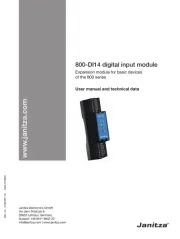
13 Mei 2025
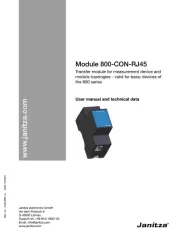
13 Mei 2025
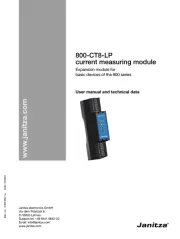
13 Mei 2025

4 Maart 2024

28 Februari 2024

12 Augustus 2023

12 Augustus 2023

12 Augustus 2023
Handleiding Niet gecategoriseerd
- Parasound
- Mesa Boogie
- Paingone
- Debel
- iBOLT
- Shelly
- Line 6
- Ibanez
- Thermex
- Alpine
- Lectrosonics
- Black Lion Audio
- Nokia
- Lava
- Lelit
Nieuwste handleidingen voor Niet gecategoriseerd
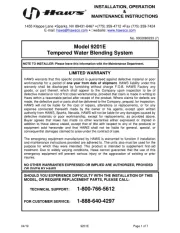
16 September 2025
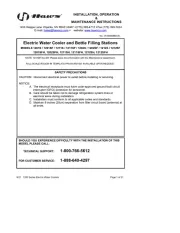
16 September 2025
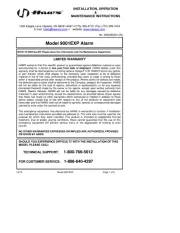
16 September 2025

16 September 2025
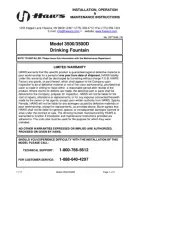
16 September 2025
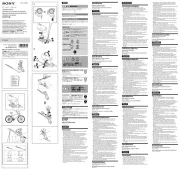
16 September 2025
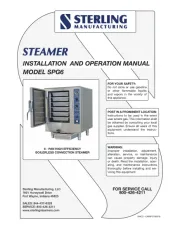
16 September 2025

16 September 2025
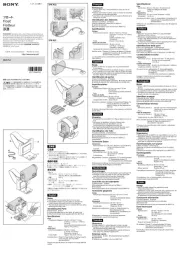
16 September 2025
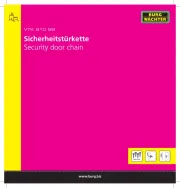
16 September 2025